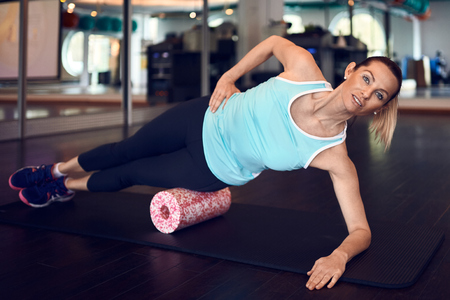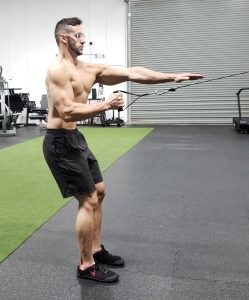We as fitness professionals most likely employ self-myofascial release (SMR) or static release techniques with most of our clients, but we could probably get more benefit by leveraging the timing and techniques to our advantage.
Start by asking yourself, “Do I feel the need to keep rolling out the same areas over and over again?” (Whether you’re working on yourself or directing a client). If so, you’re not alone. This is a common struggle in the arena of connective tissue work. There could be several variables for these kinds of foam-rolling difficulties, but for the remainder of this article, I am going to break down just a few ways to attain long lasting results from employing SMR techniques
What is SMR?
SMR is a form of pressure-induced stretching on and/or within connective tissue. As bodyworker Thomas Myers (Anatomy Trains 2014) asserts, you cannot exclusively roll fascia by itself—nerve, muscle, and epithelia are getting “rolled” too.

There are two mechanical processes that take place when performing a soft-tissue release.
Hydration: This isn’t a play on “drink more water”. This refers to what is happening to your fascia when SMR is applied. When you work into the deeper layers of fascia, you are helping move “mucus-like” fluid through the tissue.
Picture dunking a sponge in a bowl of water. Pull it out of the water and give it a good squeeze. The water typically squirts out in a small radius. This is basically what it is happening within your tissue when pressure is applied to fascia.
Releasing Tension: I love comparing this one to popping a pimple. You must apply pressure and work the surrounding areas to push the gunk from your pores, correct? With SMR you are trying to apply pressure and release the tension surrounding an adhesion or “knot”. The region of tissue that is more constricted, harder, than the areas immediately adjacent to it along the band of muscle tissue (Travell and Simons). Working those surrounding areas, will allow any adhesions to be released of tension much easier versus going directly to the source.
Lines of Pull
If we want to aid in the release of tension within the connective tissue, we must understand that the myofascial meridians all have anchor points. Which means, it’s all connected.
These lines of pull are what dictate how our bodies move through space.

If we “roll out” in our typical areas without intention of connecting to these anchor points, we are missing out on a valuable opportunity. Imagine being the coach of the All-Star basketball team, but not giving them any coaching. They probably wouldn’t know how to work with each other as well as they could with proper guidance.
Therefore, taking this moment once finished administering self-myofascial release to leverage tissue is important for optimal results. Our biomechanics will be more easily influenced during this time frame. Which means any dysfunctions that are contributing to those “always so tender” areas, will have a higher chance to be corrected.
Movements to Implement
Your abdominals are the anchor for several of your myofascial meridians. Think of gaining access to this region of your body as your “saving grace” during this time frame. This will fall back in the understanding that everyone is different, so their biomechanics will hold tension differently. Be mindful that the abdominal approach may be distinct from person to person.
Learning to engage your abdominals in different ways is crucial to maximizing your leverage points. Retracting, or pulling in, your abdominals is the technique I am referring to. This is giving you access to your transverse abdominus. This is the deeper set of your abdominals that wraps around your organs like a corset that you won’t see in your “six-pack ab” advertisements.
When you can engage this region, the real work begins. You will find your breath leading into your chest, giving you the capability to expand your ribcage more fully. This might not seem like the typical way of using your abdominals, but it is the action that most naturally occurs when we run. Performing any exercise that will recruit your glutes and your lats, such as a single-arm standing cable row will be our go-to.
Start by retracting your abdominals while pulling your breath into your chest and you will feel as if your spine has just lengthened. Then perform your single-arm row while maintaining this position. Keep your focus towards your breath and how your rib cage has expanded through the movement versus squeezing into compression. This will require stability from the opposing glute to connect with the side that is rowing the cable. This contralateral connection will simulate what contracts on the back half of your walking and running stride.
Our bodies want to be stable and balanced when in movement. Providing the right corrections to increase leverage with hydrated connective tissue can assist in this balance. The ideal feeling of this leveraged state can be defined as “tensegrity”. The continuous tension around localized compression (Anatomy Trains 2014).
Implement these simple techniques following an SMR warm-up and observe how the body responds. Do you note more stability, more congruence in movement, or fluidity? Talk to your client through the process and be sure they are tuned in to their body and proprioceptive feedback both during the SMR process and during the activities that follow. The more attuned they are to what’s happening, the more easily changes will be seen.
GUEST AUTHOR: Jerame Mudick, NFPT-CPT, is a corrective exercise specialist with over 10 years of experience. His obsession with strengthening the connection shared with mind and body, has driven his primary focus towards helping others learn to adapt to stressors in life. His mission is to help every client reconnect to their bodies natural biomechanics, free of pain.
Guest authors offer experience and educational insights based on their specific area of expertise. These authors are contributing writers for the NFPT blog because they have valuable information to share with NFPT-CPTs and the fitness community at-large. If you are interested in contributing to the NFPT blog as a guest, please send us a note expressing your interest and tell us how you can contribute valuable insights to our readers. We look forward to hearing from you! Send to editor@nfpt.com

